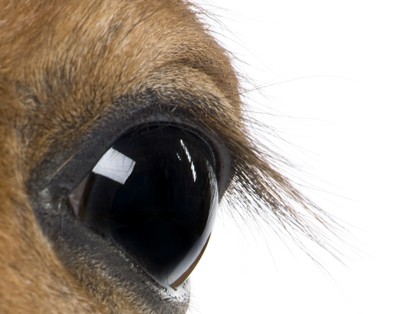Equine Leptospirosis – A Hidden Threat to Your Horse’s Health
by: Zoetis
LEPTO EQ INNOVATOR® is the first and only vaccine to help prevent leptospirosis caused by L. pomona
While not as well-recognized, the effects of equine leptospirosis can be devastating. Leptospirosis, an infectious bacterial disease, can affect mammals, including wildlife, cattle, dogs, horses and even humans.
“My mare, Patty, had a spot on her eye. I had our veterinarian examine her, and he conducted a titer test,” explained Beth Parker Woodliff, a horse owner from North Carolina in October 2016. “Patty lost her sight in that eye, and then a uveitis spot appeared in her other eye. She became totally blind, and we ended up having her put down as she wasn’t adjusting well to losing her sight. It was heartbreaking.”
The bacteria which cause leptospirosis are found in the environment across the United States. In horses, Leptospira interrogans serovar Pomona, or L. pomona, is the most common pathogen associated with disease.1
- Leptospires are a leading cause of equine recurrent uveitis (ERU).1 It’s estimated that up to 70% of all uveitis cases are associated with leptospires.2,3
- Leptospires can cause late-term abortion in mares. A study showed that 13% of bacterial abortions are caused by pomona, the most common leptospiral serovar found in horses.1
- Leptospires can colonize in the kidneys and the horse can become septicemic, potentially leading to acute renal failure.*
Urine from infected animals serves as the primary source of infection for equine leptospirosis. Spirochetes penetrate mucous membranes or exposed skin. Bacteria then enter the bloodstream, replicate and travel to the kidneys, eyes and reproductive tract.1 Infected or carrier horses can shed the bacteria in the urine.4,5 TheLeptospira bacteria can survive for weeks in warm, moist environments.2,4
Horses can become infected with Leptospira when exposed to:
- Contaminated soil, bedding, feed and drinking water5,6
- Stagnant or slow-moving water1,4
- Maintenance hosts such as skunks, white-tailed deer, raccoons and opossums
- Aborted or stillborn fetuses or vaginal discharges4,5
“Until now, options have been limited for horse owners working to help prevent leptospirosis,” said Jacquelin Boggs, DVM, MS, ACVIM, senior veterinarian, Equine Technical Services at Zoetis. “In response to the equine industry’s requests for a vaccine, Zoetis developed LEPTO EQ INNOVATOR®.”
LEPTO EQ INNOVATOR is the first and only equine vaccine to help prevent leptospirosis caused by L. pomona, the most clinically relevant serovar.1 LEPTO EQ INNOVATOR is licensed for use in all trimesters of pregnancy, and through intensive safety and efficacy trials, LEPTO EQ INNOVATOR was shown to provide a safe immune response. A study showed vaccinated horses exhibited 0% urinary shedding when challenged with L. pomona.7 Additional field safety studies showed 99.9% of vaccinated horses were reaction-free with no adverse events.8-10
For additional information on LEPTO EQ INNOVATOR and to evaluate your horse’s risk level, visit LEPTOEQINNOVATOR.com and take the Leptospirosis Risk Assessment. You can discuss your assessment results with your veterinarian and determine if vaccination with LEPTO EQ INNOVATOR is needed.
* Currently, there are no vaccines available with USDA-licensed label claims against equine abortions, uveitis or acute renal failure due to L. pomona.
1 Divers TJ, Chang Y-F. Leptospirosis. In: Robinson NE, Sprayberry KA, eds. Current Therapy in Equine Medicine.Vol 6. 6th ed. St. Louis, MO: Saunders Elsevier, 2009:145-147.
2 Polle F, Storey E, Eades S, et al. Role of intraocular Leptospira infections in the pathogenesis of equine recurrent uveitis in the southern United States. J Equine Vet Sci. 2014;34(11-12):1300-1306.
3 Borstel MV, Oey L, Strutzberg-Minder K, Boeve MH, Ohnesorge B. Direkter und indirekter Nachweis von Leptospiren aus Glasköperproben von Pferden mit ERU. Pferdeheilkunde. 2010;2(März/April):219-225.
4 Levett PN. Leptospirosis. Clin Microbiol Rev. 2001;14(2):296-326.
5 Spickler AR, Leedom Larson KR. Leptospirosis. http://www.cfsph.iastate.edu/DiseaseInfo/factsheets.php. Accessed Sept. 27, 2016.
6 Thomas H. Leptospirosis in horses. Equine Chronicle. January/February 2015. http://www.equinechronicle.com/leptospirosis-in-horses. Accessed Sept. 27, 2016.
7 Data on file, Study Report No. B850R-US-12-011, Zoetis LLC.
8 Data on file, Study Report No. B951R-US-15-092, Zoetis LLC.
9 Data on file, Study Report No. B951R-US-13-046, Zoetis LLC.
10 Data on file, Study Report No. B951R-US-13-043, Zoetis LLC.
All trademarks are the property of Zoetis Services LLC or a related company or a licensor unless otherwise noted.
© 2016 Zoetis Services LLC. All rights reserved. LEI-00054











